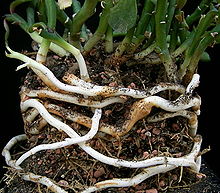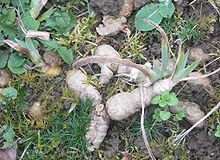Rhizome: Difference between revisions
m robot Modifying: sv:Botanisk ordlista |
+mention&ref Equisetum's unusual multi-tiered rhizomes |
||
| Line 9: | Line 9: | ||
A [[stolon]] is similar to a rhizome, but, unlike a rhizome, which is the main stem of the plant, a stolon sprouts from an existing stem, has long internodes, and generates new shoots at the end, e.g., the [[strawberry]] plant. In general, rhizomes have short internodes; they send out roots from the bottom of the nodes and new upward-growing shoots from the top of the nodes. It is a method of reproduction for plants. A stem [[tuber]] is a thickened part of a rhizome or [[stolon]] that has been enlarged for use as a [[storage organ]].<ref>Kingsley R. Stern ''Introductory Plant Biology'', 10th ed. ISBN 0072909412</ref> In general, a tuber is high in [[starch]], for example, the common [[potato]], which is a modified stolon. The term tuber is often used imprecisely, and is sometimes applied to plants with rhizomes. |
A [[stolon]] is similar to a rhizome, but, unlike a rhizome, which is the main stem of the plant, a stolon sprouts from an existing stem, has long internodes, and generates new shoots at the end, e.g., the [[strawberry]] plant. In general, rhizomes have short internodes; they send out roots from the bottom of the nodes and new upward-growing shoots from the top of the nodes. It is a method of reproduction for plants. A stem [[tuber]] is a thickened part of a rhizome or [[stolon]] that has been enlarged for use as a [[storage organ]].<ref>Kingsley R. Stern ''Introductory Plant Biology'', 10th ed. ISBN 0072909412</ref> In general, a tuber is high in [[starch]], for example, the common [[potato]], which is a modified stolon. The term tuber is often used imprecisely, and is sometimes applied to plants with rhizomes. |
||
Some plants have rhizomes that grow above ground or that lie at the soil surface, including some ''[[Iris (plant)|Iris]]'' species, and [[fern]]s, whose spreading stems are rhizomes. Plants with underground rhizomes include [[ginger]], [[bamboo]], the [[Venus Flytrap]], [[Physalis alkekengi|Chinese lantern]], [[Western poison-oak]],<ref>C.Michael Hogan (2008) ''Western poison-oak: Toxicodendron diversilobum'', GlobalTwitcher, ed. Nicklas Stromberg [http://globaltwitcher.auderis.se/artspec_information.asp?thingid=82914]</ref> [[hops]], and [[turmeric]], significant for their medicinal properties{{Fact|date=June 2009}}, and the weeds [[Johnson grass]], [[bermuda grass]], and [[Cyperus rotundus|purple nut sedge]]. |
Some plants have rhizomes that grow above ground or that lie at the soil surface, including some ''[[Iris (plant)|Iris]]'' species, and [[fern]]s, whose spreading stems are rhizomes. Plants with underground rhizomes include [[ginger]], [[bamboo]], the [[Venus Flytrap]], [[Physalis alkekengi|Chinese lantern]], [[Western poison-oak]],<ref>C.Michael Hogan (2008) ''Western poison-oak: Toxicodendron diversilobum'', GlobalTwitcher, ed. Nicklas Stromberg [http://globaltwitcher.auderis.se/artspec_information.asp?thingid=82914]</ref> [[hops]], and [[turmeric]], significant for their medicinal properties{{Fact|date=June 2009}}, and the weeds [[Johnson grass]], [[bermuda grass]], and [[Cyperus rotundus|purple nut sedge]]. Rhizomes generally form a single layer, but in [[Equisetum|Giant Horsetails]], can be multi-tiered<ref>Husby, C: ''Ecology and Physiology of the Giant Horsetails'', [http://www.fiu.edu/~chusb001/GiantEquisetum/Ecophysiology.html]</ref>. |
||
For many plants, the rhizome is used by farmers and gardeners to propagate the plants by a process known as [[vegetative reproduction]]. Examples of plants that are propagated this way include [[hops]], [[asparagus]], [[ginger]], [[iris (plant)|iris]]es, [[Lily of the Valley]], [[Canna (plant)|Cannas]], and [[sympodial]] [[orchid]]s. |
For many plants, the rhizome is used by farmers and gardeners to propagate the plants by a process known as [[vegetative reproduction]]. Examples of plants that are propagated this way include [[hops]], [[asparagus]], [[ginger]], [[iris (plant)|iris]]es, [[Lily of the Valley]], [[Canna (plant)|Cannas]], and [[sympodial]] [[orchid]]s. |
||
Revision as of 18:38, 12 August 2009



In botany, a rhizome (from Greek: ῥίζωμα "rootstalk") is a characteristically horizontal stem of a plant that is usually found underground, often sending out roots and shoots from its nodes. Rhizomes may also be referred to as creeping rootstalks, or rootstocks.
A stolon is similar to a rhizome, but, unlike a rhizome, which is the main stem of the plant, a stolon sprouts from an existing stem, has long internodes, and generates new shoots at the end, e.g., the strawberry plant. In general, rhizomes have short internodes; they send out roots from the bottom of the nodes and new upward-growing shoots from the top of the nodes. It is a method of reproduction for plants. A stem tuber is a thickened part of a rhizome or stolon that has been enlarged for use as a storage organ.[1] In general, a tuber is high in starch, for example, the common potato, which is a modified stolon. The term tuber is often used imprecisely, and is sometimes applied to plants with rhizomes.
Some plants have rhizomes that grow above ground or that lie at the soil surface, including some Iris species, and ferns, whose spreading stems are rhizomes. Plants with underground rhizomes include ginger, bamboo, the Venus Flytrap, Chinese lantern, Western poison-oak,[2] hops, and turmeric, significant for their medicinal properties[citation needed], and the weeds Johnson grass, bermuda grass, and purple nut sedge. Rhizomes generally form a single layer, but in Giant Horsetails, can be multi-tiered[3].
For many plants, the rhizome is used by farmers and gardeners to propagate the plants by a process known as vegetative reproduction. Examples of plants that are propagated this way include hops, asparagus, ginger, irises, Lily of the Valley, Cannas, and sympodial orchids.
